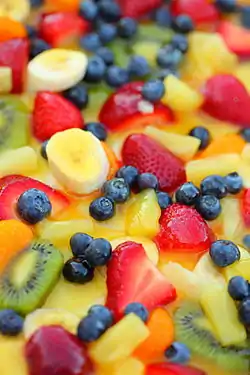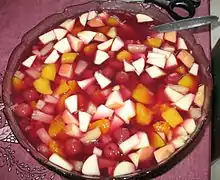Fruit salad
Fruit salad is a dish consisting of various kinds of fruit, sometimes served in a liquid, either their own juices or a syrup. In different forms, fruit salad can be served as an appetizer, a side salad, or a dessert. When served as an appetizer or dessert, a fruit salad is sometimes known as a fruit cocktail (often connoting a canned product), or fruit cup (when served in a small container).
.jpg.webp) A plate of fruit salad made of pear, satsuma mandarin, kiwifruit, passion fruit, pomegranate seeds, and Greek yogurt mixed with honey, cardamom and vanilla sugar | |
| Alternative names | Fruit cocktail, fruit cup |
|---|---|
| Type | Salad |
| Course | Appetizer, dessert, snack, main meal |
| Main ingredients | Fruit, fruit juice or syrup |
| Variations | Macedonia |


There are many types of fruit salad, ranging from the basic (no nuts, marshmallows, or dressing) to the moderately sweet (Waldorf salad) to the sweet (ambrosia salad). Another "salad" containing fruit is a jello salad, with its many variations. Fruit cocktail is well-defined in the US to mean a well-distributed mixture of small diced pieces of (from highest percentage to lowest) peaches, pears, pineapple, grapes, and cherry halves. Fruit salad may also be canned (with larger pieces of fruit than a cocktail).
Description
There are a number of home recipes for fruit salad that contain different kinds of fruit, or that use a different kind of sauce other than the fruit's own juice or syrup. Common ingredients used in fruit salads include strawberries, pineapple, honeydew, watermelon,[1] grapes, and kiwifruit.[2][3] Various recipes may call for the addition of nuts, fruit juices, certain vegetables, yogurt, or other ingredients.
One variation is a Waldorf-style fruit salad, which uses a mayonnaise-based sauce. Other recipes use sour cream (such as in ambrosia), yogurt or even custard as the primary sauce ingredient. A variation on fruit salad uses whipped cream mixed in with many varieties of fruits (usually a mixture of berries), and also often includes miniature marshmallows. Rojak, a Malaysian fruit salad, uses a spicy sauce with peanuts and shrimp paste. In the Philippines, fruit salads are popular party and holiday fare, usually made with buko, or young coconut, and condensed milk in addition to other canned or fresh fruit.
Mexico has popular variation of the fruit salad called Bionico which consists of various fruits drenched in condensed milk and sour cream mix.
There is also an extended variety of fruit salads in Moroccan cuisine, often as part of a kemia, a selection of appetizers or small dishes analogous to Spanish tapas or eastern Mediterranean mezze.
A fruit salad ice cream is also commonly manufactured, with small pieces of real fruit embedded, flavored either with juices from concentrate, fruit extracts, or artificial chemicals.
Fruit cocktail
Fruit cocktail is often sold canned and is a staple of cafeterias, but can also be made fresh. The use of the word "cocktail" in the name does not mean that it contains alcohol, but refers to the secondary definition: "an appetizer made by combining pieces of food, such as fruit or seafood". Fruit cocktail is sometimes used to make pruno, an alcoholic beverage also known as "prison wine".
In the United States, the USDA stipulates that canned "fruit cocktail" must contain a certain percentage distribution of pears, grapes, cherries, peaches, and pineapples to be marketed as fruit cocktail. It must contain fruits in the following range of percentages:[4]
- 30% to 50% diced peaches, any yellow variety
- 25% to 45% diced pears, any variety
- 6% to 16% diced pineapple, any variety
- 6% to 20% whole grapes, any seedless variety
- 2% to 6% cherry halves, any light sweet or artificially colored red variety (like maraschino cherries[5])
Both William Vere Cruess of the University of California, Berkeley and Herbert Gray of the Barron-Gray Packing Company of San Jose, California have been credited with the invention of fruit cocktail.[6][7] Canned fruit cocktail and canned fruit salad are similar, but fruit salad contains larger fruit while fruit cocktail is diced.[8]
Also in Latin America there is clericó, a popular cocktail cointaining fruit salad and wine.
In popular culture
"Fruit Salad" (also known as "Fruit Salad Yummy Yummy") is the name of a song by Australian children's band the Wiggles and on the television show Wonder Pets.
"Fruit-salad" is also a slang term used for medals on a soldiers uniform, e.g. "Look at the fruit-salad on that colonel." The term refers to the bright colors of a high percentage of the ribbons that usually go with medals.[9]
"Fruit salad" is an alternative name for the party game Fruit Basket Turnover.
See also
- Macedonia (food), a variation made of small pieces of fruit or vegetable
- Compote, dessert of fruit in syrup
- Green papaya salad, a savory salad made from unripe fruit
References
- "Watermelon Salad: A Different kind of fruit salad". Watermelon Salad. Archived from the original on 23 April 2012. Retrieved 21 April 2012.
- Barroll, M.L.H. (1913). Around-the-world Cook Book: The Culinary Gleanings of a Naval Officer's Wife. Century Company. p. 178. Retrieved December 22, 2017.
- "Very Basic Fruit Salad". Food.com. 10 March 2008. Retrieved 21 April 2012.
- "Fruit Product Sheets" (PDF). US Department of Agriculture. p. 41. Archived from the original (PDF) on 27 September 2011. Retrieved 21 April 2012.
- USDA's Grading Manual for Canned Fruit Cocktail
- Cruess, William (Vere) in The Cambridge Dictionary of American Biography: http://encyclopedia2.thefreedictionary.com/Cruess,+William
- History San José: Cannery Life: The Mystery of Fruit Cocktail: "Archived copy". Archived from the original on 2011-09-27. Retrieved 2011-11-25.CS1 maint: archived copy as title (link)
- David Arthey, P. R. Ashurst Fruit Processing Published by Springer, 1996 p. 151 ISBN 0-7514-0039-4, ISBN 978-0-7514-0039-7, 248 pages preview: https://books.google.com/books?id=tlrPylXG6WYC&pg=PA151&dq=fruit+salad+fruit+cocktail#PPA151,M1
- "Mystique Of Military Coloured Ribbons". New Straits Times. May 21, 1996. Retrieved August 13, 2010.